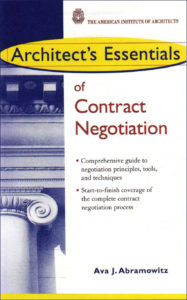
(Hoboken, NJ: John Wiley & Sons, lnc., 2009)
Architects, by and large, excel at solving problems, gaining consensus, and crafting strategic solutions that satisfy disparate sets of stakeholders. Why then, do most architects loathe negotiating? And how can architects capitalize on their skills, shift their perspective, and level the playing field when negotiating with owners, program managers, contractors, and others integral to the complicated and messy business of producing good architecture?
This is the subject of Ava Abramowitz’s second edition of Architect’s Essentials of Contract Negotiation, in which the author prods readers to become more assertive and reframe their egocentric views. She also implores architects to stop perceiving as mutually exclusive their several needs—to manage their own risks, command fees commensurate with their value, produce inspiring and responsive architecture, and help clients achieve their goals.
(A quick disclosure: I was asked to write a book about negotiating that would complement this second edition. The concept was that Abramowitz’s book would discuss negotiating concepts, while mine would take a more “how to” approach. At the time, I was helping plan the AIA national convention in San Francisco; to maintain a semblance of sanity, I respectfully declined.)
Because I had read the first edition of Abramowitz’s book and remembered it quite well, I thought I would read in their entirety only the new sections of this edition and scan the rest. But as I started reading the foreword and introduction, I got hooked again. I read a section that interested me, then another, and so on until I discovered that I had read the entire book. And it made no difference that I had read it out of order. This is a business book, not a novel, and even though later chapters build on basic negotiating principles that are covered in the beginning, the author tells you upfront that it is not important to read it in order. And right she is. Her conversational style keeps you engaged, whether you read sequentially or jump around among sections that most interest you.
The book will give you a boost of confidence that you have most of the skills necessary to be an effective negotiator. And it will likely empower you to step outside your comfort zone when negotiating, which will increase your effectiveness and enable you to make difficult choices, such as not accepting a commission. The book does an outstanding job of framing essential negotiation concepts: separating the people from the issues; focusing on principles instead of interests; maintaining alternatives to reaching an agreement; constantly probing for ways to enlarge the collective rewards; and aligning risks with those in the best position of managing those risks.
This edition successfully fills a gap in the original: skillfully told vignettes illustrate how to develop creative solutions that bridge disparate interests. Most architects will relate to her stories and will recognize some of their most difficult clients.
What the book is short on are two critical aspects of negotiating. The first is how to reach agreement with an unreasonable person who is also a desirable client (other than general suggestions such as “Don’t get angry get with it” and “Build on differences”). More real-life examples, told by architects demonstrating how to respond to unreasonable terms and unruly behavior, would have made portions of the book more valuable.
The other area pertains to a negotiator’s ingrained, personality-driven fears. Yes, most negotiating skills can be learned. But, in my experience, a negotiator’s personality has more influence on an outcome than any amount of training and knowledge. One of my colleagues, while a highly effective marketer, is a lousy negotiator for one simple reason: he lives in fear of losing a client and of not pleasing other people. How does one get past this or any other of the dozens of reasons that people avoid conflict and concede too easily in a negotiation? While Abramowitz offers advice that will empower some architects and repeatedly encourages architects to stand up for their interests, this basic challenge still exists. Most architects are smart, analytical, creative and articulate. At the same time, many of us possess fragile egos and avoid confrontation. While Architect’s Essentials of Contract Negotiation is a must-read for architects, who have to negotiate constantly, I’m hoping that the 3rd edition provides more insight into overcoming these challenging obstacles.
Originally published 4th quarter 2009 in arcCA 10.1, “Parametrics and IPD.”





